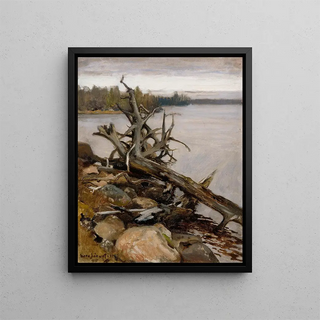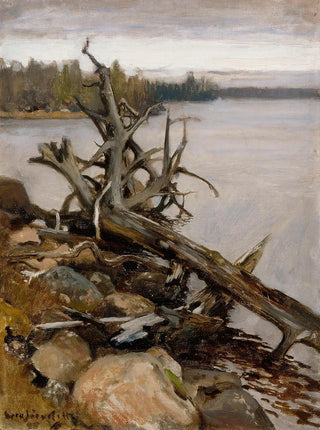Painting Pin mort dans l'eau - Eero Järnefelt | Art print


View from behind

Frame (optional)
In the world of art, certain works transcend their era and capture the very essence of human nature. "Pin mort dans l'eau - Eero Järnefelt" is one of those creations that evokes deep melancholy while celebrating the beauty of Nordic landscapes. This piece, painted at the end of the 19th century, immerses us in a peaceful environment where the tranquility of the water meets the majesty of the trees. The scene depicts a solitary pine, whose branches are reflected on the calm surface of a lake, creating an atmosphere that is both serene and contemplative. Through this art print, the viewer is invited to explore the subtleties of nature while immersing themselves in a moment of reflection.
Style and uniqueness of the work
Eero Järnefelt's style is characterized by a realistic approach that harmoniously blends with impressionist elements. In "Pin mort dans l'eau," the color palette chosen by the artist evokes delicate shades of green, brown, and blue, creating a striking visual harmony. The brushstrokes are both precise and fluid, allowing the details of the pine and the reflections in the water to come to life. This painting stands out for its ability to capture light and atmosphere, transforming a simple natural scene into a tableau of emotions. The work invites silent contemplation, where each glance reveals a new dimension of nature, while also prompting reflection on the passage of time and the fragility of life.
The artist and his influence
Eero Järnefelt, an emblematic figure of Finnish art, knew how to mark his era with his commitment to representing nature with a unique sensitivity. Influenced by the artistic movement of his time, notably realism and impressionism, he succeeded in creating a style that is entirely his own, combining technical precision with emotion. Järnefelt was a fervent defender of Finnish landscapes, and his works testify to his deep respect for the surrounding scenery. By exploring themes such as solitude and ephemeral beauty, he paved the way for a new generation of artists who sought to capture

Matte finish

View from behind

Frame (optional)
In the world of art, certain works transcend their era and capture the very essence of human nature. "Pin mort dans l'eau - Eero Järnefelt" is one of those creations that evokes deep melancholy while celebrating the beauty of Nordic landscapes. This piece, painted at the end of the 19th century, immerses us in a peaceful environment where the tranquility of the water meets the majesty of the trees. The scene depicts a solitary pine, whose branches are reflected on the calm surface of a lake, creating an atmosphere that is both serene and contemplative. Through this art print, the viewer is invited to explore the subtleties of nature while immersing themselves in a moment of reflection.
Style and uniqueness of the work
Eero Järnefelt's style is characterized by a realistic approach that harmoniously blends with impressionist elements. In "Pin mort dans l'eau," the color palette chosen by the artist evokes delicate shades of green, brown, and blue, creating a striking visual harmony. The brushstrokes are both precise and fluid, allowing the details of the pine and the reflections in the water to come to life. This painting stands out for its ability to capture light and atmosphere, transforming a simple natural scene into a tableau of emotions. The work invites silent contemplation, where each glance reveals a new dimension of nature, while also prompting reflection on the passage of time and the fragility of life.
The artist and his influence
Eero Järnefelt, an emblematic figure of Finnish art, knew how to mark his era with his commitment to representing nature with a unique sensitivity. Influenced by the artistic movement of his time, notably realism and impressionism, he succeeded in creating a style that is entirely his own, combining technical precision with emotion. Järnefelt was a fervent defender of Finnish landscapes, and his works testify to his deep respect for the surrounding scenery. By exploring themes such as solitude and ephemeral beauty, he paved the way for a new generation of artists who sought to capture
12,34 €






